Safeguarding: Youth Produced Imagery
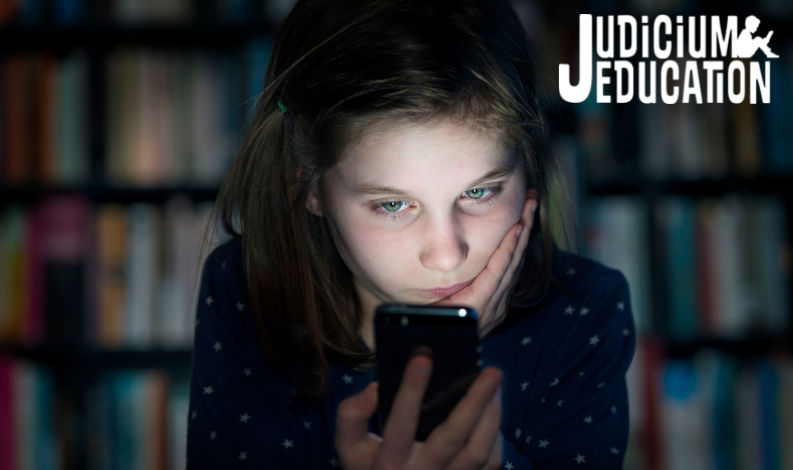
This blog is based on Judicium’s Safeguarding ‘Sofa Session’ from the 17th of May, with our resident experts Helen King and James Simoniti. This session focused on what youth produced imagery is; how to respond to cases; how the curriculum and parent engagement can support the school; and how your response to youth produced sexual imagery fits into your safeguarding culture?
Poll 1
What is youth produced imagery?
Youth Produced Imagery is known by several different names, including:
- Sharing nudes/semi nudes (this language is used in Keeping Children Safe in Education)
- Sexting (though this can sometimes relate to the text accompanying the image or sending sexual messages without any images)
Historically, other terms have been used to describe this, though these are now seen as being problematic. For example, ‘child porn’ suggests that the child is actively consenting to the arrangement. These terms should be avoided and challenged.
Essentially, these terms all describe the sending or posting of nude or semi-nude images, videos, or live streams by anyone under the age of 18 online.
The sharing of these images can be incredible problematic for those involved. Once the image is sent, that person loses control of the image, and it may be shared more widely, or even end up online, causing great distress for the those involved. If this is prevalent in your setting, it can also lead to a culture where problematic sexual conduct is accepted or seen as the norm. Most importantly, it’s illegal.
The Law
The 1978 Legislation, which dates back to a time before smartphones, refers to such imagery as ‘indecent images.’ This law states that it is ‘an offence to possess, distribute, show and make indecent images of children.’
A breakdown:- Possess –meaning to ‘have’ – whether that is a physical photograph, or as an image on your computer network/phone.
- Distribute and show – meaning to pass the image on. This could include sending the image via an app on a smartphone.
- Make – Meaning to take the photo or record the video.
- Indecent images – although not defined in law, it could include nude or semi-nude sexual posing or sexual activity with a child.
- For example, a child taking a nude image of themselves on their phone would technically be breaking the law. They would be ‘making’ and ‘possessing’ an indecent image, and if they sent it to a friend at school, they would be ‘distributing’ and ‘showing’ an indecent image.
- Ultimately, being convicted of this offence could lead to 10 years in prison.
Why do it?
Young people have different motivations and pressures for sending such images. Finnkelhor and Wolak’s typology is drawn upon in the guidance and divides two primary categories of motivation:
- Experimental – e.g., a young person sending an image to a romantic partner.
- Aggravated – e.g., a young person was groomed by an adult into sending an image or two children have ended a romantic relationship and one child sends the images they received to other young people.
Ultimately, a school’s response will differ depending on the circumstances of each individual case, but not all cases will be a simple case of young people experimenting.
How to respond to cases?
As with all safeguarding issues, the welfare of the young people involved should be the school’s primary concern and managed by the Designated Safeguarding Lead (DSL). However, all staff should understand the basic principles of dealing with a report:
- Never view, copy or share an image
- Do not delete the image
- Report it immediately to the DSL
It’s important to be mindful of the language used when responding to such incidents. It’s easy to slip into victim blaming language such as ‘well that was silly’ or ‘why would you send that to someone you’ve never met?’ Although these can often be the first things that cross people’s minds when hearing about this, it does not help the situation. The child may feel more upset, worried and stop elaborating which leaves them at greater risk.
NB: Staff only need to take the initial report, offer reassurance, and report it to the DSL who should lead the response to the situation.
Initial Review
Upon receiving a report, the DSL should hold an initial review meeting with relevant members of staff and gather any further information needed to establish the facts. The risk assessment is important, as it informs the next steps that should be taken. Important considerations include:
- Was the imagery shared consensually? Or is there evidence that the young person has been coerced or blackmailed into sending the image?
- Has the imagery been shared beyond its intended recipient and where has it been shared?
- The age of the young people involved (Two 10-year-olds sharing imagery would be different to two 17-year-olds.)
- Is the young person especially vulnerable? Has this happened before?
- What is the impact on the child involved?
If the assessment deems the child is at risk of harm, or has been harmed, then this should be referred to children’s social care and/or the police.
However, in certain circumstances, the guidance states that a referral should always be made. These are for incidents where:- An adult is involved
- There is a belief that the young person has been coerced, blackmailed, groomed or does not have the capacity to consent.
- The sexual acts displayed are unusual for the young person’s stage of development.
- The young person depicted in the imagery is under 13 and the imagery involves sexual acts.
- There is a belief that a young person is at immediate risk of harm due to the incident, e.g., self-harming.
If none of the above apply, the school may decide to respond to the incident internally in line with their school policy.
The Police Response
Although young people sharing nudes and semi-nudes is technically a criminal offence, the police will rarely look to prosecute young people doing this consensually as there is often no public interest in this course of action. However, when the police become aware of this activity, they are duty bound to record this as a criminal offence and technically, this could show on an Enhanced DBS in the future. For a matter to be shown on an Enhanced DBS, the Chief Officer would need to reasonably believe that:
- The information is relevant to the purpose of the disclosure.
- The information ought to be included.
If the information doesn’t pass this two-stage test, it will not be included. It is unlikely two young people consensually sharing images would meet these criteria.
There will be limited occasions when the police will look to prosecute this activity. For example, if there is a significant imbalance of power, such as a 17-year-old and an 11-year-old.
Some of these incidents will not be picked up by officers who specialise in working with children. NB: If something does not sit right with you, challenge and escalate the matter.
Case Studies
Referring to the police:
A 14-year-old girl in your school has recently gone missing from home and arrived at school with unexplained gifts. The DSL is concerned that she is being groomed, so speaks with her alone. The pupil discloses that she was bought the gifts by her new ‘boyfriend’, a 20-year-old man who lives locally. She says he buys them for her in return for her sending him videos of her performing sexual acts.
The DSL decides to refer this to children’s social care and the police for the following reasons:- There are concerns that the child has been groomed.
- There is an adult involved.
This matter fits under the ‘aggravated’ criteria mentioned earlier. A strategy meeting is held, and children’s social care and the police explain their plan moving forward. The DSL explains that the school can offer counselling and a workshop on healthy relationships. All agencies work together to ensure that the child is safe and supported as best as possible.
Dealing with the matter internally:
Two 15-year-old pupils at your school are in a relationship. One of their friends confides in the DSL she is worried about them as they regularly send each other nude images and she knows it is illegal. The DSL has never had any concerns about either of these pupils before and speaks with both pupils separately. Both explain that they do send such images, but they always do this consensually and enjoy doing this. The images are not shared with anyone else and are stored on the pupils’ devices.
The DSL decides not to refer this to children’s social care or the police as this fits best under experimental rather than aggravated. None of the aggravated criteria have been met and they believe they have the capacity to understand what they are doing.
However, the DSL does the following:
- Advises the pupils the activity is illegal and to possess these images is committing a criminal offence (but also explains the law is there to protect young people.)
- Advises the pupils to delete the images and checks in with them at a later date to ensure they have done it (without checking the device.)
- Signposts them to local agencies offering support.
- Informs parents (as this would not put the pupils at greater risk)
- Ensures that an upcoming INSET day training session focuses on the sharing of nudes.
- Ensures that an upcoming RSHE session focuses on healthy and unhealthy relationships.
Supporting the young people involved
Once the risk has been assessed, if the child is not at immediate risk, you will likely need to have a conversation with the young person. This is normally the DSL, but if the young person has a preferred trusted adult who could support here, this should be facilitated where possible. The DSL should be assured this member of staff is equipped to have this conversation.
The conversation should cover:- What the image contains and who has been involved.
- Who or where it has been shared.
- What actions can be taken to prevent further distribution.
- The views and wishes of the child.
- Reassure the child the setting is there to support them.
- Support their parents and carers to understand what has happened.
- Use solution-focused language not victim blaming language.
- Explore the wider pressure the child may have faced.
- Discuss issues of consent and trust within a healthy relationship and what is and is not appropriate from a partner or trusted person.
- explain the law in relation to this.
- Advise on how to delete the image by using the IWF and Childline’s Report Remove Tool (NB: the sooner this is done the better), explain how to report concerns on individual sites and to inform the school about any bullying behaviour.
Where a child has shared another child or young person’s image it should be explored whether:
- Did they request the image?
- What are the next steps to be taken to remove it.
- What are the motivations for sharing the photo and how to manage this.
How can the curriculum and parent engagement support the school?
Poll 2
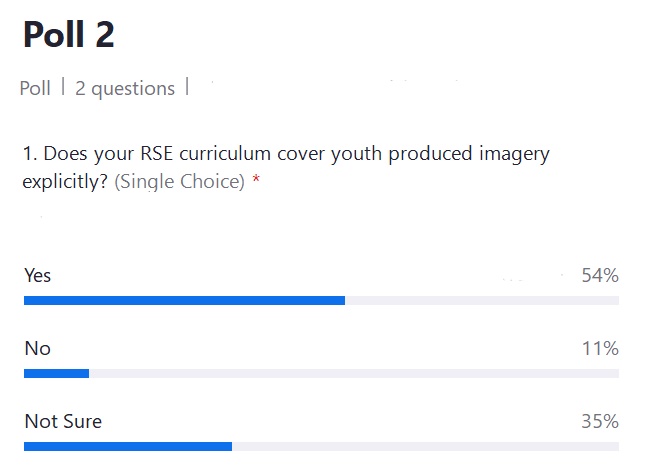
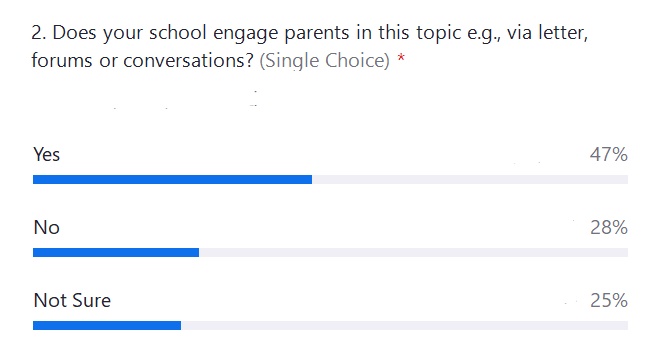
Being proactive with your school’s curriculum and parent engagement can help to put you ahead and help avoid hitting a crisis point.
Research suggests it is now becoming part of normalised behaviour for young people. In more recent research presented in a DfE webinar, it was suggested that nearly half of 14-year-old males have actively engaged in sexting and the first exposure to sexting seems to be around 12 years old. The likelihood a young person will engage with sexting increases as they get older.
If accurate, schools may need to reconsider their RSE curriculum. If the data from students is showing that young people are beginning to have their first exposure at 12 years old (year 7), perhaps some of this learning may need to sit in the upper years of KS2 as well.
Analysing your data can support in this area:- Review your sexualised incidents and your incidents that fall under this category.
- Consider surveying students (whilst making parents aware of the rationale for this) about their knowledge of this area and whether they have received or been asked for any images. This will give you a sense of the typical picture for your school, make sure you can analyse it based on gender and different age groups.
This information can give you the foundation for reviewing the curriculum and opening up conversations with parents about the need to share information on this topic earlier if necessary.
Parents may also want to know what they can do to support with this. Consider sharing the above information, e.g., what good practice looks like in your school if you receive a disclosure of a nude or semi-nudge image. You can explain to them how you would support the young person and what language you might avoid. This information can empower parents to feel competent and ready if they have to face supporting their child. It will also make conversations easier and more predictable if you find you need to speak to parents about their child.
NB: For detailed information on how to have conversations in different scenarios, see the sharing nudes and semi-nudes guidance from the government 2.7 Supporting Parents and Carers.
Curriculum
You will address this topic through both the PSHE curriculum around body image and the RSE curriculum for sex and romance.
Tip 1: Consider what aspects should be addressed through body image and which through RSE.
Tip 2: Consider how best to teach this topic and importantly, given the Ofsted Rapid Review, whether staff are confident in teaching this topic.
- We would recommend completing staff training ahead of teaching the RSE curriculum for the first time. This is so staff get a chance to complete activities like deliberate practice around a topic and plan for any ‘curveballs’ in the lesson. It will help staff feel more confident in delivering the lesson.
- If you do decide to use external people to deliver on this topic, The UK Council for Internet Safety have a guidance document to support you with this.
Tip 3: Most importantly, whichever part you decide to use to cover youth produced imagery, ensure it is not just a standalone item and is part of a carefully sequenced curriculum.
From our experience the best practice we have seen is in schools who survey their students on what they gained from their RSE lessons. This includes questions around knowledge they have acquired - particularly useful for a non-examinable subject - and around how useful they found the lessons. This has allowed them to refine the curriculum further.
We also see good practice around learning walks to check staff are confident in delivery and students are maximising the learning.
What we tend to find is less effective is lessons which are centrally planned, uploaded a day before the teacher must teach them with no exploratory or quality preparation time for the staff, and offer no feedback loop.
How does your response to youth produced imagery fit into your safeguarding culture?
Areas to consider:- Do students trust that if they make a disclosure to you regarding this, it will be taken seriously, dealt with appropriately and they will not be made to feel to blame for this?
- Are parents clear on the school approach and understand what the school will do if incidents occur?
- Do staff know how to deal with an incident aside from simply passing onto the safeguarding team? E.g., do they know what could happen next? Could they offer that vital reassurance to students.
- Does the curriculum adequately cover this topic at the most impactful time?
- Are staff confident in delivering it? Have they had an opportunity to explore the topic and practice it?
Resources for parental engagement - https://www.thinkuknow.co.uk/parents/articles/7-questions-parents-ask-about-nude-selfies/
https://www.thinkuknow.co.uk/parents/Listing/?cat=&ref=4765#mMain
DfE sharing nudes and semi-nudes Guidance - https://www.gov.uk/government/publications/sharing-nudes-and-semi-nudes-advice-for-education-settings-working-with-children-and-young-people/sharing-nudes-and-semi-nudes-advice-for-education-settings-working-with-children-and-young-people#sec2
You can follow us on Twitter: @JudiciumSG @JudiciumEDU
If you’d like to review Judicium’s forthcoming sofa sessions please click here
© This content is the exclusive property of Judicium Education. The works are intended to provide an overview of the sofa session you attend and/or to be a learning aid to assist you and your school. However, any redistribution or reproduction of part or all of the contents in any form is prohibited. You may not, except with our express written permission, distribute or exploit the content. Failure to follow this guidance may result in Judicium either preventing you with access to our sessions and/or follow up content.
Related content
.png)
This is a summary from Judicium’s Safeguarding and Thrive ‘Sofa Session’ from 3rd December, with our Judicium Safeguarding consultant Joanne Bocko, Thrive Head of Innovation and Principal Trainer, Viv Trask-Hall and Director of Thrive, Tom Preston. Drawing on decades of combined experience in safeguarding, governance, SEND, leadership, and mental health, the panel unpacked how the framework’s shifts will impact schools, what Ofsted will be looking for, and how leaders can position themselves for success.

This is a summary taken from Judicium’s SEND and Safeguarding ‘Sofa Session’ from 5th November, with our Safeguarding and SEND consultants Rik Chilvers and Simon Hanley. In this session we discuss the new SEND and Safeguarding toolkit and how to best prepare for an Ofsted visit.
.png)
This blog is based on Judicium’s Safeguarding Client Survey Uncovered - Insights from the sofa session from 8th October with our Safeguarding Consultant Joanne Bocko.
.png)
This blog is based on Judicium’s Safeguarding - Back to school: Are you KCSIE ready? sofa session from 10th September with our Head of safeguarding, Kate Massey . In this session we take a look at the key updates for KCSIE 2025, and how best to prepare for the start of the new academic year.

This blog is based on Judicium’s Safeguarding Supervision On The Sofa: Your DSLs Safe Space ‘Sofa Session’ from the 25th June 2025, with our resident experts Helen King and Sarah Cook.
).png)
Supervision is dedicated time for professionals to reflect openly on the challenges of the cases they manage. This blog explores the common misconceptions, myths and the all important benefits to Safeguarding Supervision. Don't miss our Safeguarding Sofa Session on Supervision: Your DSLs safe space on 25th June at 10am OR 11:30am.

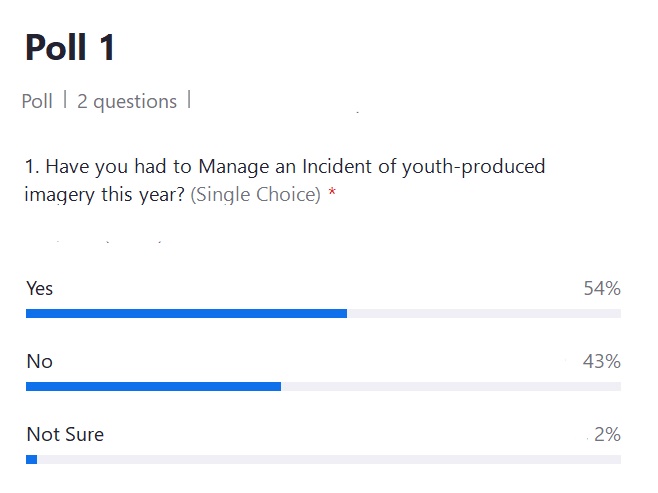
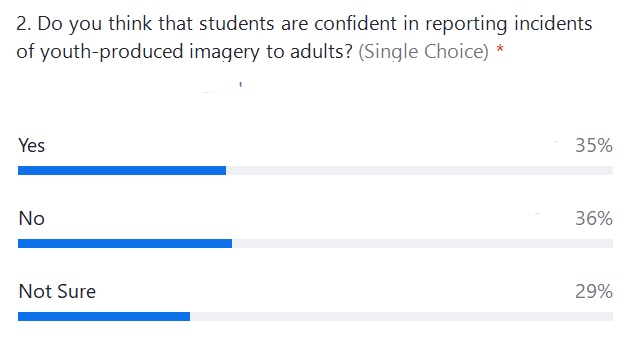
Sofa Sessions | Safeguarding